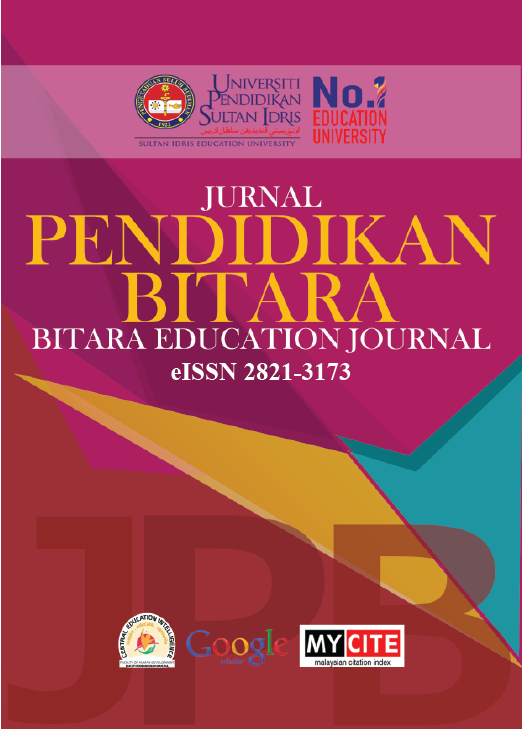Implementation of “kombar" in receptive and expressive language skillsin children with autism disorder
DOI:
https://doi.org/10.37134/bitara.vol12.6.2019Keywords:
pictorial communication, receptive languange, epressive language, autismAbstract
Pictorial Communication (KOMBAR) is an approach that can be used as an alternative method in training communication skills among children with special needs. This action research was conducted to investigate the effect of using KOMBAR approach in enhancing the development of receptive and expressive English language among children with special needs. Three students with autism disorder were selected for this study. The initial survey found that students with autism had difficulty communicating in English due to their limited vocabulary which prevented them from communicating in simple English. Observation methods are used when students perform activities using the KOMBAR approach. Meanwhile, pre and post tests were used to see changes in achievement in the methodology used for the receptive and expressive mastery of autism students in English.Data from the module given over 3 months were video recorded to see the effectiveness of the KOMBAR approach used in English teaching. The findings indicate that children with special needs showed an increase in vocabulary and were able to communicate using simple English after the "KOMBAR" approach was introduced and applied in the teaching process in the classroom. This research supports that "KOMBAR" is an alternative approach which helps students with special needs enrich their vocabulary and able to communication in simple English.
Downloads
References
Boucher J. (2012). Structural language in autistic spectrum disorder - characteristics and causes. Journal of Child Psychology and Psychiatry 53(3), 219–233.
Brady, N. C.; Storkel, L.H.; Bushnell, P.; Michael Barker, R.; Saunders, K.; Daniels, D. & Flemingb, K. (2015). Investigating a multimodal intervention for children with limited expressive vocabularies associated with autism. American Journal of Speech-Language Pathology 24: 438–459.
Fein, D.; Barton, M. & Dumont-Mathieu, T. (2017). Optimizing outcome in autism spectrum disorders. Behavioral and Brain Sciences 4(1): 71–78.
Flippin, M.; Reszka, S.; & Watson, L.R. (2010). EffectIveness of the picture exchange communication system (PECS) on communication and speech for children with autism spectrum disorder: a meta-analysis. American Journal of Speech-Language Pathology 19: 178-195.
Ganz, J.B; Earles-Vollrath, T.L.; Heath, A.K.; Parker, R.I; Rispoli, M. J. & Duran, J.B. (2012). A meta-analysis of single-case research studies on aided augmentative and alternative communication systems with individuals with autism spectrum disorders. Journal of Autism and Developmental Disorders 42(1): 60-74.
Ganz, J.B.; Hong, E.R.; Goodwyn, F.; Kite, E. & Gilliland, W. (2015). Impact of PECS tablet computer app on receptive identification of pictures given a verbal stimulus.Developmental Neurorehabilitation 18(2): 82-87.
National Research Council. (2001). Educating children with autism. Washington, DC: National Academy Press.
Norburn, K.; Levin, A.; Morgan, S.; & Harding, C. (2016). A survey of augmentative and alternative communication used in an inner-city special school. British Journal of Special Education 43(3), 259-306.
Park, C.J.; Yelland. G.W.; Taffe J.R. & Gray, K.M. (2012). Morphological and syntactic skills in language samples of preschool-aged children with autism: a typical development? International Journal of SpeechLanguage Pathology 14(2), 95–108.
Pasco, G. & Tohill, C. (2015). Predicting progress in the Picture Exchange Communication System (PECS) use by children with autism. Journal of Language& Communication Disorders 46(1), 120-125.
Tek, S.; Mesite, L.; Fein, D. & Naigles, L. (2014). Longitudinal analyses of expressive language development reveal two distinct language profiles among young children with autism spectrum disorders. Journal of Autism Development Disorder 44(1), 75–89.
Tager-Flusberg, H.; Rogers, S.; Cooper, J.; Landa, R.; Lord, C.; Paul, R.; Rice, M.; Stoel-Gammon, C.; Wetherby, A. & Yoder, P. (2009). Defining spoken language benchmarks and selecting measures of expressive language development for young children with autism spectrum disorders. Journal Speech-Language-Hearing Residual.52(3), 643-656.
Volkmar, F.K.; Lord, C.; Bailey, A.; Schultz, R.T.; & Klin, A. (2004). Autism and pervasive developmental disorders. Journal of Child Psychology and Psychiatry 45, 135-170.
Downloads
Published
Issue
Section
License
Copyright (c) 2019 UPSI Press

This work is licensed under a Creative Commons Attribution-NonCommercial-ShareAlike 4.0 International License.





